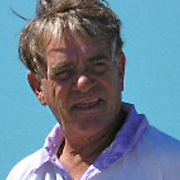
Howard Moses
As a child Howard Moses fell in love with ice-skating, and film. After taking on projectionist duties at his Christchurch primary school, he would go on to hold the NZ junior speed skating title, aged 14. Celluloid and snow soon became major themes. Moses did time as a ski instructor, and dabbled in filmmaking. Some of the films were shot on Super 8, mailed to Australia for processing, then screened the following Saturday night.
After majoring in zoology and psychology at Canterbury University, Moses got a master in sociology and public relations.
A job as an extra on landmark early 70s series Pukemanu marked a key turning point. Among the actors on set were members of the Blerta creative team. Soon Moses found himself helping drive the famous Blerta bus during a tour of the West Coast. Along the way, Geoff Murphy and Alun Bollinger taught him how to use a Bolex camera.
In 1978 Moses joined the documentary department of the NZBC, where he arranged locations for shoots in and around Christchurch. When Moses formed his company Tango Film Company four years later, workmates were told they'd be fired if they helped him in any way.
The idea to make a series of ski films had been born during ski adventures taken with members of the NZ ski team. 1984 awardwinner Across the Main Divide followed a trio — including US telemark champ Whitney Thurlow — as they travelled across the Southern Alps, to the West Coast. After positive reviews and screenings on 14 ITV stations in the UK, TVNZ reversed an earlier decision, and played it in a primetime Saturday evening slot. Across the Main Divide also screened at Kiwi consulates and British military bases across the globe, and won awards at two festivals devoted to mountain films.
Skiing and scenery were also at the centre of Incredible Mountains, which follows a Southern Alps ski competition for local and off season northern skiers (organised by Coast to Coast impresario Robin Judkins). Here and on the other ski films, legendary mountain climber Paul Scaife (who later died in an avalanche on Mt Cook) provided insight into the development of the high alpine crossing and the heli-ski sections of Turn of the Century. In turn Moses would direct promo films for Scaife's heli-ski company.
In 1987, after four years of filming and research Turn of the Century was completed. The documentary traces the history of skiing and winter sports in New Zealand, from the days of home-made skis and weather reports by carrier pigeon, to commercial ski lifts and fields. The film incorporated footage from another film made in this period: Zimska Olimpijada, which saw Moses and a small at the Sarajevo Olympics in Yugoslavia, recording among other things the moment when Torvill and Dean accumulated the highest score for figure skating in Olympic history.
Zimska Olimpijada sold to 32 territories, and was "by near-unanimous acclaim" the grand prize winner at a festival of mountain films in Telluride, Colorado. Judges noted that America's ABC network, "with all its minions and millions didn't unearth a fraction of the beauty that this small (27 minute) film did."
In 1991 Moses relocated across the Tasman, and began a decade in Western Australia. During eight years in Fremantle he directed and edited a wide range of material, from documentaries to music videos. Among them were episodes of Artists Up Front, a series on aboriginal artists, a documentary shot during a sailing race from Fremantle to Indonesia, and a much used guide for mariners dealing with severe weather.
Since then Moses has worked behind the scenes at television stations in Broome (as senior editor/director), Darwin and Auckland (helping prepare archive material for Māori Television). He also spent time helping install radio and television transmitters across the outback. In 2004 Moses began five years at ABC's Darwin base, editing local news items and handling exchanges of broadcast material across the country.
Sources include
Howard Moses
Peter Shelton, 'Dateline: Dallas Divide' - Telluride Mountain Journal, 28 May 1987